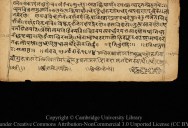New Thesis Claims May Have Decoded 2,500-Year-Old “Language Machine”
by Ashley Dreiling
More than 2,000 years ago, Indian scholar Dakṣiputra Pāṇini created a complex rule book for the complex workings of the ancient Sanskrit language.
In a recently published thesis, Ph.D. student Rishi Rajpopat from the University of Cambridge claims to have decoded the seemingly contradictory guidelines in Pāṇini’s “language machine.”

Photo Credit: Cambridge University Library CC-By-NC-3.0
Known as the “father of linguistics,” Pāṇini described the rules of modern syntax and semantics. Perhaps his most significant work is the “language machine” that describes how words and formed and relate to others from the same language, now known as morphology.
Often likened to how early computers constructed letters and words into cohesive dialects, Pāṇini’s algorithm creates grammatically correct Sanskrit words and those of many other languages. However, scholars have long struggled with some of the machine’s rules for word generation, specifically when more than one rule could be reasonably applied but no instructions on which one is correct.

Photo Credit: Pexels
Enter Rishi Rajpopat and his theory that the scholars’ problems don’t come from Pāṇini’s rules, but rather from how others interpret his instructions, specifically that Pāṇini’s metarule for the sequence of grammar has been largely misunderstood. Instead of considering it as the serial order, Rajpopat applies the rule to the left and right sides of words, with the right side given precedence.
Rajpopat’s successful interpretation of Pāṇini’s foundational work could have significant future implications in the field of linguistics. It may not only help us decode aspects of modern languages but advance the ever-changing way that humans intelligently communicate with computers.
Categories: SCI/TECH
Tags: · algorithm, ancient language, Dakṣiputra Pāṇini, decode, father of linguistics, language, language machine, languages, linguistics, metarule, modern language, morphology, Rishi Rajpopat, Sanskrit, semantics, syntax, thesis, top, University of Cambridge, word, words

Sign up to get our BEST stories of the week straight to your inbox.




